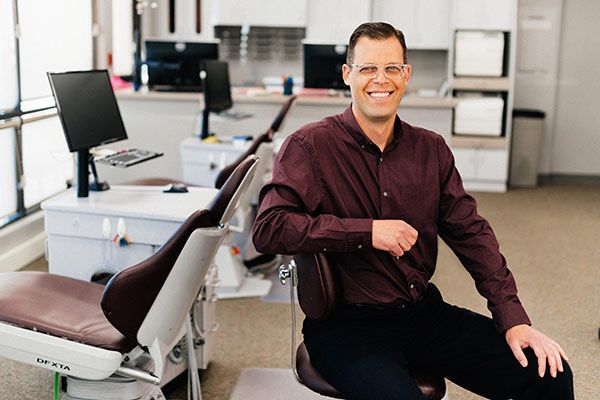What is an orthodontist?
Dr. Warren Libby, DDS
Let's begin at the beginning. What is orthodontics and dentofacial orthopedics? And what exactly is an orthodontist? Don't dentists do orthodontics? Glad you asked! Orthodontics is the process of moving teeth by applying controlled and precise pressure to teeth over time. This pressure stimulates changes in the bone that allow the teeth to move. Planned and completed with the proper skill and care, this tooth movement results in straighter teeth and improved bite function. Applying force or pressure to the teeth can be done many different ways (braces, Invisalign, modified retainers, springs, rubber bands, etc.), but the physiological process of moving teeth is the same no matter how the pressure is applied.
Some orthodontic movements require changes in the bone structure itself, rather than simply moving teeth. Dentofacial orthopedics is the process of changing bone structures in the face. This can be done several different ways. The most common would be a rapid palatal expander. Jaw surgery would also change the bone structures in the face. The reason for orthopedic changes is to get the bones in the right place to support the correct placement of the teeth. Properly placed teeth and bone structures give you a vibrant smile, good chewing and bite function, and long-term stability for overall oral health. Your orthodontist is trained to evaluate and address how all these factors interact, determine the most appropriate options for your treatment, and then carry out that treatment effectively and efficiently.
The Derheims success story at Murray Orthodontics is inspiring, now mom and daughters have a healthy smile!
So, what is an orthodontist anyway? An orthodontist is a dental specialist, a dentist who has taken focused and intensive training in a particular area of dentistry while in a program or residency that is accredited by the dental profession to grant specialty status to their graduates. Training and education to become an orthodontist generally includes a four-year college degree with a curriculum that includes many science classes to prepare for dental school. College is followed by dental school, another four years, with clinical and classroom training. After dental school and completing the licensure process, one may practice general dentistry, but may not claim specialty status. Becoming an orthodontic specialist requires two to three years additional training (depending on the particular residency program) after dental school in an accredited orthodontic residency program, after completion of which one is able to practice the specialty of orthodontics exclusively. All orthodontists are dentists. One cannot become an orthodontist without also being a dentist. In other words, all orthodontists have the same training as general dentists, as well as additional training to be recognized as a specialist.
Some orthodontic residency programs provide a master's degree upon completion. Others provide a certificate upon completion. Both the certificate and the master's degree allow an orthodontist to practice the specialty of orthodontics. Completion of the master's degree requires additional academic work, such as research, along with the clinical and classroom training to perform orthodontics. This is why some orthodontists have the letters MS (Master of Science) after their name, and some do not. The certificate and master's degree do not indicate any difference in expertise or skill, they are simply related to the type of residency program completed. (While we are on the subject of letters after names, there are generally two different certifications for general dentistry in the United States. One is DDS, which stands for Doctor of Dental Surgery. The other is DMD, which stands for Doctor of Dental Medicine. The difference is purely convention; there is no substantive difference between the dental school programs that give DMD versus DDS degrees. All are held to the same educational standards.)
General dentists have a wide latitude in the procedures they are allowed to perform. This can include and overlap with procedures that dental specialists are trained in, such as complex extractions of teeth, root canals, gum surgeries, dentistry for children, and orthodontics. A dentist's ability to do these things well is generally acquired through continuing education courses and experience. Dental specialists restrict their practice to their specialty, for which they have completed a multi-year residency program. So, your general dentist is capable of performing orthodontics, but does not have the training and additional education that your orthodontist does.
Finally, you may have noticed that your orthodontist is "board certified." Certification by the American Board of Orthodontists is not required to practice orthodontics; it is optional and voluntary to take the exam to be board certified. Board certified orthodontists have taken the time and effort to study and hone their expertise to pass the board examination. Currently about 60% of practicing orthodontists have chosen to become board certified. If your orthodontist is board certified, you know that they have gone the extra mile in their dedication to the profession. Both Dr. Libby and Dr. Murray are board certified.
Thanks for reading!
Dr. Warren Libby, DDS

